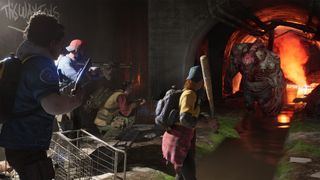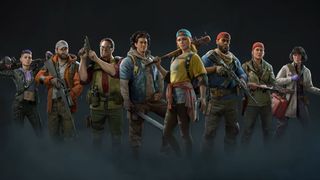Back 4 Blood still isn’t Left 4 Dead 3, and that’s okay
Left 4 Dead and Back 4 Blood shouldn't be head 2 head

Back 4 Blood can’t escape the shadow of Left 4 Dead, the hugely successful co-op zombie shooter developer Turtle Rock built with Valve. Every new trailer for Back 4 Blood was met with a flood of commenters comparing Turtle Rock’s new game to its spiritual predecessor.
Except, Left 4 Dead is more than a shadow behind Back 4 Blood. We have no control over our shadows, and the relationship between these two games isn’t a passive one. Left 4 Dead is more of a cloak: something the developer chose to wrap Back 4 Blood in, explicitly referencing the game in early vision statements.
And Left 4 Dead’s flapped behind Back 4 Blood from then on: players have compared the game’s characters, saying Back 4 Blood’s aren’t as memorable and saying Back 4 Blood’s Swarm mode isn’t a patch on Left 4 Dead’s Versus mode.
But does inviting comparisons, and even trading on them, mean that Back 4 Blood should be condemned as just a failed successor? The cloak hides the deliberate differences of the two games, and if you’re looking for Left 4 Dead 3, you’ll miss what makes Turtle Rock’s newest zombie shooter special.
When zombies collide

Across two Left 4 Dead games, Turtle Rock gave us eight memorable characters. It never expanded the playable characters roster, sticking to its guns on four per game and packing each one with personality.
While the Left 4 Dead games didn’t follow a linear story, the incidental dialogue between the cast fleshed out these characters and the state of the world they fought through. But in terms of their game mechanics, there were no distinctions: Vietnam veteran Bill played exactly the same as mechanic Ellis. They didn’t have any special abilities, individual character stats, or unique weapons. If I want to run into an oncoming zombie horde armed with a pistol, I will have as much a chance of surviving the fight as either character, though playing as Ellis I might hear him talk about his (possibly imaginary) friend Keith, and as Bill I might learn about one of his war exploits.
In Back 4 Blood, Turtle Rock went in a different direction. Following the competition in the co-op genre, such as Vermintide 2’s talent trees, Dead By Daylight’s perks, or Payday 2’s character roles, Back 4 Blood’s characters aren’t interchangeable – each has unique perks and abilities, and you can use cards to buff and empower them on missions.
Getting to play a character the way you want is good - player agency and choice are what keep me returning to games years after their release. I’m still pouring hours into games such as Final Fantasy Tactics because I can build on what I’ve done in previous playthroughs. I can experiment in my own gaming science lab. I’m not ready to place Back 4 Blood on the same shelf as Final Fantasy, but I can see that promise of choice and agency under the cloak.
Back 4 Blood’s cards introduce a wide range of customization possibilities, letting you construct a deck that fits your play style. I found myself drawn to shotguns as a personal favorite zombie-clearer, but I was able to make it more my own with a card that gave me temporary health with each hit. But more important than my personal satisfaction, the abilities give Back 4 Blood’s characters a mechanical identity, something Left 4 Dead’s cast never had. Back 4 Blood has a veteran character similar to Bill, called Walker. But he’s more than a gruff exterior. Walker has an ability that makes special enemies’ do less damage, so I used cards that make his attacks debuff them too. So for me, Walker became a supportive leader thanks to his gameplay and his personality.
By opting to include eight characters instead of four, and giving each unique traits, Turtle Rock hasn’t been able to give the characters the same narrative attention as their compatriots in Left 4 Dead. And while there is a tradeoff for a deeper system of gameplay, a level-to-level item economy, and the ability to customize characters to your playstyle – all great things – Back 4 Blood’s characters deserve more credit than user reviewers on Metacritic give them.
How I learned to stop worrying and love the zom

Every memorable character leaves behind an impression.
Bill is a gruff-but-lovable Vietnam vet. Nick is a pessimistic con man who bleeds sarcasm. Ellis is an irrepressible mechanic, and always has another weird story to tell.
Not every one of Back 4 Blood’s characters lands for me, but some of them really worked. Hoffman is probably my favorite of the gang, the paranoid shut-in who has as many minor ailments as he has conspiracy theories; he even looks a bit like Dan Akroyd to really seal the deal. I thought I’d find him obnoxious, but his earnest attempts to fit in with the rest of the group and the stories about his childhood asthma only made his conspiratorial rants more endearing. It probably helps that Back 4 Blood’s zombies are mutated by a parasitic worm from space. So in the end, Hoffman is actually proved right.
Mom really hit her stride for me too. Her name is on the nose, as, while she’s a tattooed biker-type, she’s clearly the one who cares most about the rest of the gang. I was drawn to playing her since I really like helping my team and being the one to rescue people. Despite her superficial similarity to Bill, Mom is softer to me, more rounded and caring, with something to live for despite having suffered the loss of her son – killed on a zombie-clearing run – whereas Bill seems to have a foot out the door most of the time.
Heng, who came with the expansion, is a great sign of what’s to come, even if I feel like I’ve just started to get to know him. His references to punk exploits in his youth, and complaints about how unsanitary things are compared to his restaurant kitchen, are surreal and perfect.
None of the runs I’ve had on Back 4 Blood’s streets has felt perfect. I fondly remember Versus mode from Left 4 Dead, because no matter how well you played, if you got cocky you could always snatch defeat from the jaws of victory. Back 4 Blood’s Swarm mode doesn’t capture that same magic for me, it just doesn’t have the same tension.
But Back 4 Blood’s main mode does inspire the same feelings I had playing through Left 4 Dead runs with friends. I get the same old thrill looking for caches to loot, managing my different accessories, and keeping my teammates from becoming appetizers for stray shamblers. But now I also spend time looking at my cards in the deckbuilder, trying to figure out what neat builds I could try, what cards might end up influencing my playstyle, or countering the undead AI director.
When I make a run in Back 4 Blood, I still think of Left 4 Dead. Undead crowds, dark streets and fields, wrecked cars, and bottles of painkillers. But when I do, I smile at the memories, and then I laugh at the latest line poking fun at Hoffman.
And then I unload my shotgun into a crowd of the dead to gain some temporary health. And I think to myself that Back 4 Blood is doing just fine on its own.
Get daily insight, inspiration and deals in your inbox
Get the hottest deals available in your inbox plus news, reviews, opinion, analysis and more from the TechRadar team.

Phil is a Senior Writer of TechRadar Gaming (TRG). With three previous years of experience writing freelance for PC Gamer, he's covered every genre imaginable. For 15 years he's done technical writing and IT documentation, and more recently traditional gaming content. He has a passion for the appeal of diversity, and the way different genres can be sandboxes for creativity and emergent storytelling. With thousands of hours in League of Legends, Overwatch, Minecraft, and countless survival, strategy, and RPG entries, he still finds time for offline hobbies in tabletop RPGs, wargaming, miniatures painting, and hockey.
